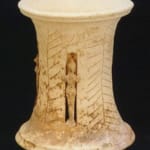Syrio-Hittite Sculpture, 2100 BCE - 1600 BCE
Terracotta
7.5 x 9
PF.3336
Syria, to the south of Anatolia and west of Mesopotamia, was a crossroads between the great civilizations of the ancient world and was often disputed by rival powers. The rulers...
Syria, to the south of Anatolia and west of Mesopotamia, was a crossroads between the great civilizations of the ancient world and was often disputed by rival powers. The rulers who controlled the land held vital trade routes linking the Mediterranean world and Asia. There are four alternating "windows" which hold a female figure, the fertility goddess Astarte. One female figure is missing. These female figures are characterized by an elongated pillar-like lower body that flares at the bottom to create a base for the figurine. The upper body reveals one or more necklaces with a series of incised lines that may represent beads. The abbreviated arms appear as wings and their headdresses may signify special status. There are many incisions on the lower body, and incisions on the chest area represent breasts. The figurines have prominent projecting noses but no mouths. Two of the figurines have small designs covering themselves below the navel, while the other has a long skirt on. They have swelling body forms in the rear. The form of this sculpture is rare. It may have been placed in the center of a room to radiate its sacred energy to all who encircled it. Perhaps the four fertility goddesses symbolized the four seasons. We are drawn again and again through this mystical composition, compelled to wonder how it was used in reverence and what was the nature of the ceremony. This beautiful sculpture shows the iconographic and representational richness of terracotta production in Syria.



